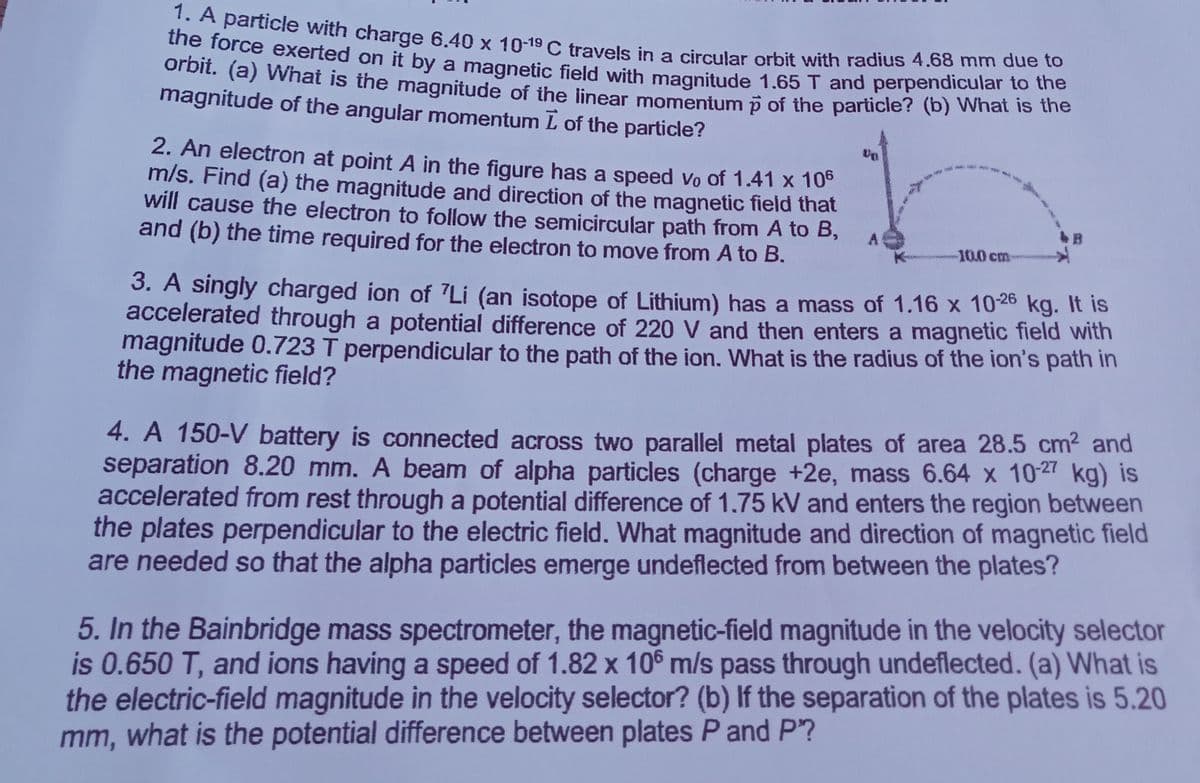A particle with charge 6,40 x 10-19 C travels in a circular orbit with radius 4.68 mm due to the force exerted on it by a magnetic field with magnitude 1.65 T and perpendicular to the orbit. (a) What is the magnitude of the linear momentum p of the particle? (b) mat is uio magnitude of the angular momentum L of the particle? 2. An electron
A particle with charge 6,40 x 10-19 C travels in a circular orbit with radius 4.68 mm due to the force exerted on it by a magnetic field with magnitude 1.65 T and perpendicular to the orbit. (a) What is the magnitude of the linear momentum p of the particle? (b) mat is uio magnitude of the angular momentum L of the particle? 2. An electron
Chapter11: Magnetic Forces And Fields
Section: Chapter Questions
Problem 108CP: A wire ismade into a circular shape of radius R and pivoted along a central support.The two ends of...
Related questions
Question

Transcribed Image Text:the force exerted on it by a magnetic field with magnitude 1.65T and perpendicular to the
1. A particle with charge 6.40 x 10-19 C travels in a circular orbit with radius 4.68 mm due to
ne rorce exXerted on it by a magnetic field with maanitude 1.65 T and perpendicular to the
orbit. (a) what is the magnitude of the linear momenium p of the particle? (b) What is the
magnitude of the angular momentum L of the particle?
2. An electron at point A in the figure has a speed vo of 1.41 x 10°
m/s. Find (a) the magnitude and direction of the magnetic field that
will cause the electron to follow the semicircular path from A to B,
and (b) the time required for the electron to move from A to B.
-10.0 cm
3. A singly charged ion of Li (an isotope of Lithium) has a mass of 1.16 x 1026 kg. It is
accelerated through a potential difference of 220 V and then enters a magnetic field with
magnitude 0.723 T perpendicular to the path of the ion. What is the radius of the ion's path in
the magnetic field?
4. A 150-V battery is connected across two parallel metal plates of area 28.5 cm2 and
separation 8.20 mm. A beam of alpha particles (charge +2e, mass 6.64 x 102 kg) is
accelerated from rest through a potential difference of 1.75 kV and enters the region between
the plates perpendicular to the electric field. What magnitude and direction of magnetic field
are needed so that the alpha particles emerge undeflected from between the plates?
5. In the Bainbridge mass spectrometer, the magnetic-field magnitude in the velocity selector
is 0.650 T, and ions having a speed of 1.82 x 10® m/s pass through undeflected. (a) What is
the electric-field magnitude in the velocity selector? (b) If the separation of the plates is 5.20
mm, what is the potential difference between plates P and P?
Expert Solution
This question has been solved!
Explore an expertly crafted, step-by-step solution for a thorough understanding of key concepts.
Step by step
Solved in 3 steps

Knowledge Booster
Learn more about
Need a deep-dive on the concept behind this application? Look no further. Learn more about this topic, physics and related others by exploring similar questions and additional content below.Recommended textbooks for you


Principles of Physics: A Calculus-Based Text
Physics
ISBN:
9781133104261
Author:
Raymond A. Serway, John W. Jewett
Publisher:
Cengage Learning

College Physics
Physics
ISBN:
9781938168000
Author:
Paul Peter Urone, Roger Hinrichs
Publisher:
OpenStax College


Principles of Physics: A Calculus-Based Text
Physics
ISBN:
9781133104261
Author:
Raymond A. Serway, John W. Jewett
Publisher:
Cengage Learning

College Physics
Physics
ISBN:
9781938168000
Author:
Paul Peter Urone, Roger Hinrichs
Publisher:
OpenStax College

Glencoe Physics: Principles and Problems, Student…
Physics
ISBN:
9780078807213
Author:
Paul W. Zitzewitz
Publisher:
Glencoe/McGraw-Hill

Physics for Scientists and Engineers: Foundations…
Physics
ISBN:
9781133939146
Author:
Katz, Debora M.
Publisher:
Cengage Learning